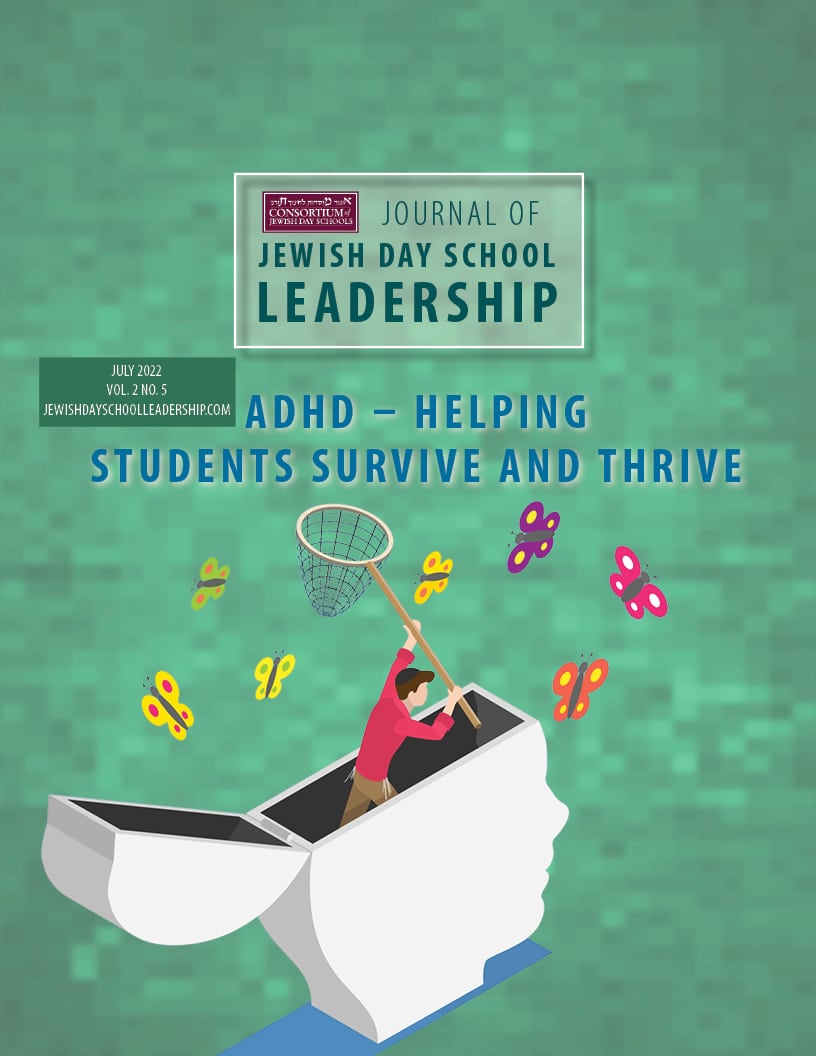
ADHD Students and Their Teachers – Who Needs the Help?
July 18, 2022
Start Here: ADHD
July 18, 2022by Mrs. Devora Malka Goldstein
“Shmully, sit down.”
“Sara, what are you supposed to be doing now?”
“Why are you across the room?”
“Your chair is not supposed to be in the air.”
“Morah what were the directions again?”
“Rebbi I didn’t hear what you said (fifteen times).”
As a teacher, these scenarios can be very frustrating, but how does the student feel? What can we, as teachers, do to support these students in our classrooms?
We are in a unique position as classroom teachers. There are many students in our classroom, each one has varied needs, strengths, ideas, and abilities. In most cases, there is one teacher, who has the role of guide, teacher, nurturer, caregiver, and more to each of these children all at the same time! How is that even possible? How can we teach the academic child, the non-academic child, the learning-disabled child, and the ADHD child all at once?
I will offer you a quick trick that can help you support each student, all the time. Know their strengths. As a classroom teacher, I was expected to come up with an end of year reward for each student. I would spend hours coming up with an academic award and a social-emotional award for each student. I would leave the year with such love for each child, now that I found their strengths. What if we stop in the middle of each marking period to find each child’s strengths?
I would like to share with you some of the common strengths of the ADHD child to help jumpstart your list.
- The ability to hyperfocus for an extended period of time on something, which can lead to completed assignments and projects.
- The ability to be creative and think towards potential and possibilities.
- The ability to be easily excited and have endless energy.
- The ability to be spontaneous.
- The will and desire to do for anyone- very generous.
- The ability to be a leader.
- The ability to look past prior mistakes to move forward.
- The ability to creatively problem-solve.
- The ability to debate.
- The ability to work well in groups.
- The ability to be good natured.
- The ability to stay strong for their values.
- The ability to be resilient and persevere for something they believe in.
How do each of these strengths play out in the classroom?
Below are a few scenarios that occurred in the classroom. As you read through each scenario, try to think about the strengths of each of these students. (Note that it will be significantly easier when they are not in your classroom or your responsibility.) Identify at least one strength for each student with the limited information given and think about at least one way the teacher can use that child’s strength to support their learning.
Scenario 1
Chana, a third-grade student, is sitting at her desk. She is working on a shorashim worksheet. The directions are to color the shoresh in each word green, the prefixes yellow, and the suffixes blue. Each student pulled out their supply box and got started right away. Most of the class has completed the assignment rather quickly. Some students did a neater job, and some did a sloppier job, but they have gotten it done and are heading out the door to recess. Chana took a while to get started. She pulled out her supply box, but most of her markers were not inside. She spent a few minutes searching, and only managed to unearth the yellow and the blue markers. No green in sight. Chana had an insight; she could make green! As she went through each word on the page, she highlighted the prefix and shoresh in yellow, the suffix and shoresh in blue, and voila! Her worksheet was completed properly. She was hard at work and so excited by her strategy, she didn’t hear the teacher tell her to get ready for recess or notice that the class had gone outside.
Scenario 2
Zalman is on the playground with his class. One area of the field is muddy, a second is taken up by the big boys, and the preschool is out there also. A bunch of boys are grumbling about how there is nowhere to go and nothing to do and they are just wasting their time. The class’s definition of nothing to do is that they cannot play baseball. They are about to go ask their Rebbi if they can just go inside and skip recess, and Zalman swoops in with excitement, telling them about this great game he learned in camp last summer. He gets all of the boys excited to hear about it. He goes on and on, explaining the intricacies of the game. A few boys start to question him, but he draws them back in. The game gets started, and the class has a great time.
Scenario 3
Simmi is never at her desk. She is usually wandering around the classroom. She does well on all of her tests and assignments, when she remembers to hand them in. She doesn’t appear to be paying attention to what her teacher is saying, but sometimes she will jump in with the most on target comment, question, or argument. Despite not appearing engaged, she is one of those students who keeps the teacher on her toes. She needs to have all her lessons well prepared and thought out, because Simmi will find any “holes.”
Scenario 4
Gamliel is a rambunctious first grader. He can’t stay in his seat and control himself from calling out. He is often one of the first students finished with an assignment. He loves learning and has the best attitude, even when rebuked for his actions.
Scenario 5
Chavi has an affinity for paper airplanes. If she gets a piece of paper in her hands, it quickly becomes an airplane. She has entire fleets made, using her homework sheet, even before it makes it home. When the teacher demands Chavi search her backpack and locker for her missing assignments, she is presented with a fleet of airplanes!
Scenario 6
Chayala is whimpering in the corner of her classroom. She isn’t happy with the snack her mother packed, and although Morah listened and validated her feelings, she just wants a different snack. Shaindy, a lively kid in Chayala’s class (who isn’t really one of Chayala’s friends), sees Chayala and her heart goes out to her. She forgot her lunch again today, but nonetheless digs through her school bag, sure that there must be some extra snacks leftover in there somewhere. Shaindy often forgets to clean out her bag, but on days like today it can come in handy! She finds a closed bag of Bisli at the bottom of her bag, and it sounds like there are whole pieces in there when she shakes it. She goes over to Chayala and shares the bag of Bisli with comforting words, giving up the only chance she had at eating a snack this morning.
In our classrooms, there are all sorts of students. Some are very creative, some are very intellectual, some can sit still, and some need to jump around! Sometimes our students with ADHD (diagnosed or not) can be our most challenging students, but when we teach and manage behaviors in a way that plays to their strengths, everyone can succeed.
Looking back at the above students, what are some of the strategies we can use that will support our students in a strengths-based approach?
- Chana (Scenario 1) is a great problem solver! She also seems to be very creative. She may do very well with learning through scenarios and figuring out a deeper understanding of concepts. Chana may enjoy being given puzzles to complete. Any creative project will enable her to learn the material in order to present it in art form.
- Zalman (Scenario 2) shows great leadership skills and enthusiasm. He would be an asset to any class by the teacher enabling him to buy into whatever activity there is to do. From the scenario, it would appear that Zalman can get the class excited about almost anything. If the teacher were to first approach Zalman with a program or a project and make him a “partner” in planning the way it will be presented to the class, not only will Zalman do well on the task at hand, but he will likely get everyone else on board.
- Simmi (Scenario 3) loves to stand and walk around. It appears as if she would benefit from an adjustable height desk or flexible seating. She is engaged and an asset to the class as she clarifies things with the teacher for the benefit of all. Seating Simi in an area of the classroom where she would not impact others with her movement or assigning areas of the classroom where she has permission to wander and areas that are off limits may be beneficial.
- Gamliel (Scenario 4) is either your favorite or least favorite type of student. When he is absent, the tone of the class is different. He is the student that constant feedback is important. Rewarding him for controlling his behavior with high stakes rewards will usually be effective (if rewards don’t work, the stakes are probably not high enough or the reward is probably not frequent enough). If consistency and novelty of the prize are not maintained, he may be back at his old habits quickly. When something grabs his interest, he is all in, so pulling examples from things that excite him will be to your benefit.
- Chavi (Scenario 5) and her paper airplanes (or any other obsession) are a challenge and an opportunity in the classroom. Chavi can demonstrate how to make various types of airplanes each day at the end of class if she wasn’t busy with them during class. This allows her to shine among her peers and allows her to get her schoolwork completed at the same time.
- Shaindy (Scenario 6) probably often has a messy desk and school bag. It also sounds like she would give the shirt off her back to anyone in need. Shaindy would probably do well with a checklist for different parts of the day. A morning checklist could include coat and school bag in your locker, HW in the HW tray on Morah’s desk, siddur on your desk, pencil sharpened. A recess checklist could look like: Desk clear, supplies in supply box, no garbage on the floor under and around your desk. A checklist should never include more than 5-7 items, each one a single step. Shaindy could even be given a homework checklist that would include homework completed, homework placed in folder, school bag cleaned out. Of course, she would have lost her chessed opportunity with a clean bag.
There are ways to support all students in our classrooms. Some strategies require more effort, some require less effort. Seeing each student for their strengths helps catapult them to success. What strengths can you find in your students today?
Mrs. Devora Malka Goldstein is an ADHD Coach and an Instructional Coach living in South Bend, Indiana. She has a dual Masters in Education and Special Education from Touro Graduate School of Education and Psychology. After more than 18 years in the classroom, successfully supporting all types of learners, she has transitioned to coaching new teachers and working one on one with ADHD clients to support them to gain the motivation and skills they need to succeed. She can be reached through her website: www.dmgcoachingandconsulting.com.

